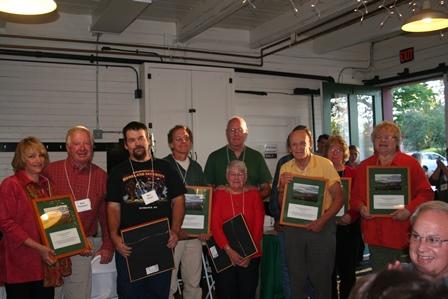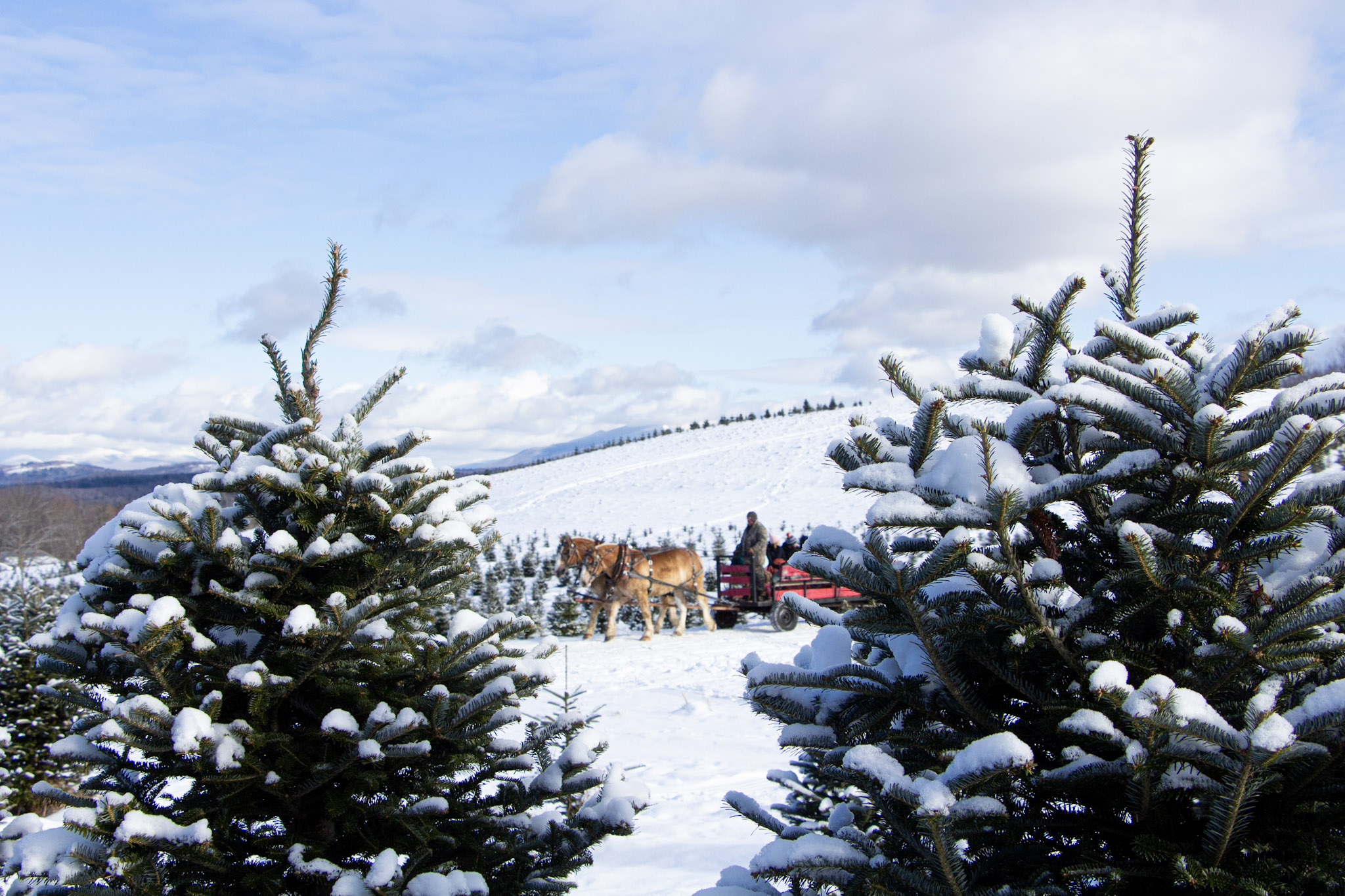President/Forester Jane Difley's Remarks at Annual Meeting 2015

Some of the Forest Society's 2015 Conservationists of the Year, honored for taking a strong stand against Northern Pass. Photo by Diane Forbes.
I was at the recent Northern Pass public input session in Whitefield and was reminded, as I am from time to time, that people expect to me to “speak for the forests.” They don’t mean me personally, but rather that they expect the Society for the Protection of New Hampshire Forests to defend the forests when they perceive them to be under attack.
And make no mistake, most of the 300 people who packed the Mountain View Grand think that their forests are under attack from out-of-state interests.
I did speak that night, calling on Northern Pass to take full advantage of new transmission cable technology, bury their proposed line in its entirety, and spare our forested landscape from an unnecessary scar. Burying only a third of the line is not enough—northern and southern New Hampshire towns deserve to have their scenery and property values protected no less than the White Mountain National Forest.
But the truth is that in my role as President/Forester I spend far more time listening on behalf of the forests than I ever do speaking in their defense. I think that in order to speak for something, to advocate, then one must listen carefully first.
And my goodness isn’t there a lot to listen to these days!
I suppose it is a sign of our organization’s influence—which is to say our members’ influence—and our long history that so many people are eager for the Forest Society to come to their rescue.
Wind projects in central New Hampshire, gas pipelines in southern New Hampshire, oil pipelines in northern New Hampshire, communications towers in coastal New Hampshire, and one particularly giant transmission line down through the middle of New Hampshire -- it does seem like the developers of such things have their sights set on places where fewer people are likely to make a fuss.
There’s an odd perception that a forest left to do what it does—that is, to grow trees, take up carbon, filter water and be home to wildlife—is nonetheless “empty.” Or as one such developer asked me, “Why do you care if we put towers and powerlines through that forest? There’s nothing there!”
Never tell a forester that it’s ok to fragment and industrialize a working forest because “there’s nothing there.” I have full faith in that if a tree grows in a forest and there’s no one there to see it, it still exists. And I have yet to see a logger get much value at the mill for a steel tower.
I don’t think we will fight every battle people would like us to fight. And we will listen carefully to those who make legitimate, compelling arguments for projects with true public benefit that come with impacts on forests. But I also would say that you can count on us to defend conserved lands, speak up for the forests, and urge others to do the same.
The Day-to-Day Work
While our advocacy sometimes grabs the most headlines, I am perhaps most proud of our organization’s ability to continue the critically important land protection and land stewardship work for which we are known. Our staff—your staff—sets the standards in our industry through the work they do. At the state and national level, their advice is sought out by other land trusts. And in their quest to always improve, to find efficiencies, to learn, they seek out new and better ways to accomplish our goals. They are dedicated, determined, they work too hard, and our accomplishments reflect that.
Most of you likely have heard me say that conservation affords people the chance to be part of something larger than themselves. This is certainly true for landowners who conserve their land, and I find it’s true for donors who support our land conservation work. I know it’s true for our many volunteers because they tell me so. I believe this is the most important way that our organization truly becomes a “Society,” and I think we all—you, me, our staff, our board, our volunteers—take immense pride and consider it a great honor to have a small part in every one of our land conservation projects. We all become a part of something larger than ourselves when we enable a landowner to choose permanent conservation.
In the past fiscal year ending in May, we conserved almost 6,300 acres through 20 different projects. Those are the numbers. You can find more numbers in our annual report in your packets. For me, though, more important than the numbers are the people. For example, among our guests here tonight Marilyn Johnson, Jim and Ann Hochschild and others who worked together to create the Johnson-Clark Nature Preserve here in Bethlehem that some of you visited today on a field trip. Neighbors, perhaps inspired by the conservation work done around them, working together to create their own legacy—something larger than themselves -- by donating easements on 241 acres.
Conservation leads to conservation. We thank—I thank-- all those landowners, donors, members and volunteers who continue to make our work possible.
Stewarding the Future
This is our 115th year of “perpetuating New Hampshire’s forests through their wise use and complete reservation in places of special scenic beauty.” But as much as we like to celebrate what we have accomplished year after year over the course of more than a century, I believe we must look ahead. We must ask ourselves, “What will what the forests of New Hampshire need from our organization in the future? What do we need to prepare for those future needs?”
It’s a challenge because, as the late Yogi Berra is credited with saying, “The future isn’t what it used to be.”
(I’m told that Yogi Berra played baseball. I will have to take others’ word for it.)
Our board and staff have been contemplating those questions, and we all continue to listen closely to you and other important stakeholders as we seek answers.
I believe that ours will be the century of Stewardship. We must prepare and equip ourselves for the sustainable stewardship of the lands we own, the easements we have pledged to hold, and the organization that enables that work to be done. We must challenge ourselves to embrace new ways of thinking and new technology. We must embrace stewardship as opportunity rather than burden.
We must make it possible for Stewardship, like Land Conservation, to enable us all to become part of something larger than ourselves.
Our board recognizes that to accomplish those broad goals, we must stay relevant. Just as we stand on the shoulders of those conservationists who came before us, we must foster the conservation ethic and broaden our own shoulders to support those who follow us.
And to do that, we must engage more people.
Fortunately, we have a secret weapon. In fact, we have 180 secret weapons located in more than 100 communities in New Hampshire, and they are the 54,000 acres of Forest Reservations we own and manage. These represent our opportunities to remind people that forests are not dark and scary places, that they are full of life and hardly “empty.” And that in our forests, people are welcome. That we are truly a Society of the forests, and that our lands—like here at the Rocks—are the real gateway to a true New Hampshire experience.
Listening to the Forest
I started this report by noting that I am often expected to speak for the forests. I will leave you with this.
I think it’s true—or I would like to think it’s true—for the people in this room, people who might call ourselves conservationists, that the forests speak to us.
Granted, we may each hear something a little different. For some of us, a forest speaks when it reverberates with the sounds of children at play, exploring, climbing , laughing. The sounds of wonderment.
For some of us, we hear the forest in the nearly-silent footfalls of a hiker along a trodden path, the occasional trip over an exposed root. Perhaps the pant of a faithful dog scouting the trail ahead.
Some of us hear the forest in the dee-dee-dee of a chickadee, the squeak-and-scrunch of a chipmunk scurrying through the leaves, the drum of a ruffed grouse, or the snort of a white-tailed deer startled by our arrival.
If we are still, we can hear the forest in a breeze that sets free an acorn from its oak, landing with a muffled plonk in the duff. With a little imagination, we can hear the forest speak when we turn on the tap in our kitchen to draw a glass of cool, clean water or draw in a deep breath of clean air.
And for some of us, the sound of the forest crescendos when a mature tree is harvested, the crack of upper branches as the tree falls leading to that satisfying “whump” on the forest floor. A well-felled tree is full of meaning for our species---it is warmth from our woodstove in the winter, a sturdy home, a favorite chair, the paper in our book and even the light that lets us read it. Or, if you must, the power for your Kindle.
It can be difficult to hear the forest in places where there are more people than trees. Where machines and televisions and mobile devices define our world. In large halls where people argue loudly over building the next big box store, the next parking lot, the next powerline. In these places, the forest sometimes needs help. And while I am happy to speak up as President/Forester, it cannot be a solo--our forests need a choir like you to sing their praises.
Let forests be forests.
Thank you.
